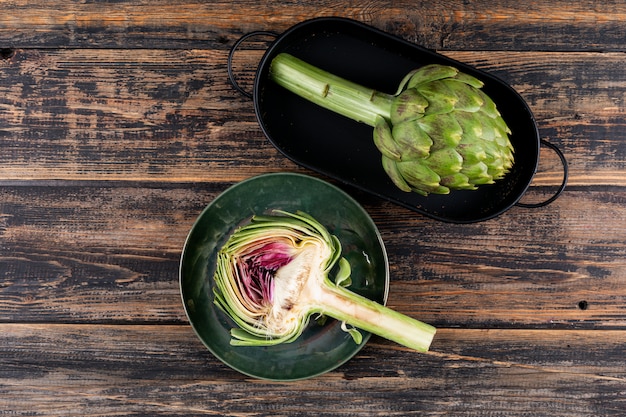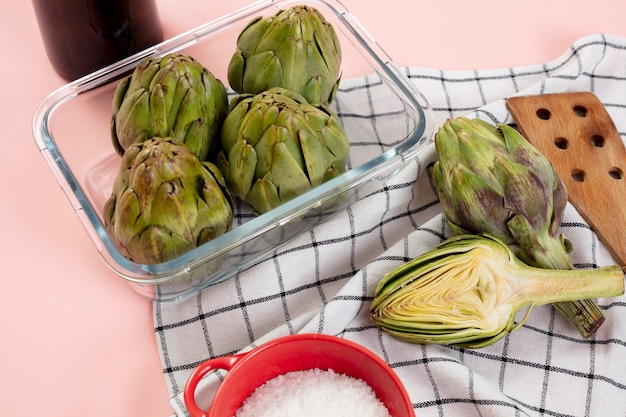Let's be honest, artichokes can seem a bit intimidating at first glance. They're prickly, they're unfamiliar, and they just look... complicated. For years, I avoided them, assuming they were some kind of culinary enigma reserved for fancy restaurants. But one day, a friend insisted I give them a try, and I'm so glad I did. It was a revelation! Artichokes are actually incredibly versatile and delicious, and steaming them is a fantastic way to unlock their full flavour potential.
Beyond the delicious, tender hearts, there's a whole experience to be had. Peeling back layer after layer, revealing the treasure within, is a bit like life itself. But I digress. The point is, once you learn how to steam artichokes, you're opening the door to a whole new world of culinary delights. And I'm here to guide you every step of the way, from choosing the perfect artichokes to steaming them to perfection, and even how to enjoy them like a pro.
(Part 1) Choosing Your Artichokes

The first step is selecting the right artichokes. Trust me, nobody wants to spend time steaming a disappointing one! It all starts with a good selection.
Look for Freshness:
Here's what you need to look for when choosing your artichokes:
- Tightly Closed Buds: fresh artichokes will have tightly closed buds. It's a sign that they're not past their prime and haven't started to open up. You want them to feel compact and firm.
- Heavy for Their Size: A plump artichoke is a good one! They should feel heavy for their size, indicating they're full of moisture and flavour.
- Bright Green Colour: Look for a vibrant green colour. Any dullness or browning suggests they're past their prime. You want a fresh, bright green colour that pops.
- Firm Leaves: The leaves should be tightly packed together, feeling firm and resilient. Avoid any that are loose or have broken tips.
- No Signs of Damage: Steer clear of artichokes with bruises, cuts, or any other kind of damage. They might be bruised on the inside too, affecting their flavour.
Size Matters:
The size of your artichoke depends on how many you're feeding, and honestly, how much artichoke you're after! A larger artichoke will provide a generous amount of heart, perfect for sharing. Smaller ones, however, are ideal for a solo adventure or a more intimate meal.
(Part 2) Preparing Your Artichokes:

Now that you have your perfect artichokes, it's time to prepare them for steaming. Don't worry, this is much easier than it seems. It's all about removing the tough bits and making them ready to absorb the steam.
1. Trim the Top:
Using a sharp knife, trim off the top inch or so of the artichoke, including the pointy leaves. This part is the toughest, and you won't want to eat it. This step also helps the steam penetrate the heart more easily.
2. Remove the Outer Leaves:
Start peeling away the tough, outer leaves. You'll feel them give way with a bit of pressure. Keep removing the outer leaves until you reach the softer, lighter green leaves. These outer leaves are usually too tough to eat, but you can save them to make a delicious vegetable stock.
3. Trim the Stem:
If the stem is long and thick, use your knife to trim it down to about an inch. You can use the trimmed stem in your stock, too!
4. Open the Leaves:
Gently pull apart the remaining leaves to open up the artichoke. This allows the steam to penetrate the heart evenly and tenderise it properly.
5. Rub the Cut Edges:
Using a lemon half, rub the cut edges of the artichoke with lemon juice. This is a simple trick to prevent the artichoke from browning and keeps it looking fresh.
6. Optional:
If you're a bit squeamish about texture, you can remove the choke, the fuzzy, hairy part in the centre of the artichoke. It's not strictly necessary, though. To remove it, use a spoon to gently scoop it out. You can also find pre-trimmed artichokes that already have the choke removed.
(Part 3) Steaming Your Artichokes:

Now, for the magic! We're ready to steam your artichokes, allowing the heat and moisture to work their wonders.
1. Get Your Steamer Ready:
Grab a steamer basket and place it in a large pot. Fill the pot with about an inch of water. Bring the water to a rolling boil over medium heat.
2. Add Your Artichokes:
Once the water is boiling, carefully place your prepared artichokes in the steamer basket, making sure they're not overcrowded. You want them to have space to cook evenly.
3. Steam to Perfection:
Cover the pot and steam the artichokes for about 30 to 45 minutes, or until the leaves are tender enough to pull apart easily. You can test the artichoke by gently pulling on a leaf. If it comes away easily, it's ready.
(Part 4) Serving and Eating Your Artichokes:
The moment of truth has arrived! Your artichokes are steamed to perfection, and the aroma is divine. But how do you actually eat them? Let me guide you through the experience.
1. The Classic Method:
This is the traditional way to eat an artichoke, and it's all about savoring each layer. Start by pulling off a leaf, holding the base. Dip the fleshy part of the leaf into your favorite dip (more on that later!) and gently scrape the fleshy part against your teeth. It might sound a bit unusual, but trust me, it's a delicious and satisfying way to eat an artichoke.
2. The Spoon Method:
If you're not a fan of the classic method, you can use a spoon. Once you've eaten all the leaves, you'll reach the artichoke heart. Scoop out the heart with a spoon and enjoy the tender, flavorful bite.
3. Dips Galore:
Choosing the right dip is crucial for enhancing the artichoke experience. Here are a few of my favorites:
- Classic Butter and Lemon: Simple, but oh-so-delicious. Just melt some butter and squeeze a little lemon juice over it. It's a classic for a reason!
- Aioli: This creamy garlic sauce is a perfect match for the artichoke's earthy flavour.
- hollandaise sauce: Rich, decadent, and always a crowd-pleaser. It adds a luxurious touch to your artichoke experience.
- Olive Oil and Herbs: Mix olive oil with your favorite herbs, such as parsley, basil, or oregano, for a refreshing and aromatic dip.
(Part 5) Artichoke Tips and Tricks:
You've mastered steaming artichokes, but let's go beyond the basics and delve into some handy tips and tricks!
1. Saving Leftovers:
If you have leftover artichokes, you can store them in the refrigerator for up to 3 days. Simply wrap them in plastic wrap or store them in an airtight container.
2. Freezing artichoke hearts:
You can also freeze artichoke hearts for later use. Simply steam them as directed, then let them cool completely. Store them in a freezer-safe bag or container. When you're ready to use them, simply thaw them overnight in the refrigerator and they're ready to go!
3. Other Ways to Enjoy Artichokes:
Don't limit yourself to steaming. Here are some other ways to enjoy artichokes:
- Grilled: Brush artichoke hearts with olive oil and grill them for a smoky, charred flavour.
- Sautéed: Cut artichoke hearts into bite-sized pieces and sauté them with garlic and olive oil. They're perfect as a side dish or as part of a pasta dish.
- Roasted: Toss artichoke hearts with olive oil, herbs, and lemon juice, and roast them until tender.
- Added to Pasta: Toss artichoke hearts into your favourite pasta dishes for a burst of flavour.
- In Salads: Add artichoke hearts to your salads for a textural contrast and a burst of flavor.
(Part 6) The Benefits of Artichokes:
Let's be honest, artichokes are delicious, but did you know they're good for you too? They're a nutritional powerhouse, packed with vitamins, minerals, and antioxidants. Here are some key benefits:
1. Rich in Fibre:
Artichokes are a great source of dietary fibre, which helps promote digestion, regulates blood sugar levels, and keeps you feeling full.
2. Packed with Antioxidants:
Artichokes are rich in antioxidants, which help protect your cells from damage caused by free radicals. This helps protect against chronic diseases.
3. May Help with Liver Health:
Artichokes contain cynarin, a compound that may help support liver function.
4. May Help Lower Cholesterol:
Some studies suggest that artichokes may help lower cholesterol levels.
(Part 7) Exploring the World of Artichokes:
Now that you've mastered steaming artichokes, you're ready for the next level! There's a whole world of artichokes to discover, each with its own unique characteristics.
1. Types of Artichokes:
There are actually many different types of artichokes, each with its own unique flavour and texture. Here are a few common varieties:
- globe artichoke: The most common type of artichoke, with a large, round head. This is the one you'll likely find most readily available at your local grocery store.
- Roman Artichoke: Smaller and more tender than globe artichokes, with a distinctive, pointed shape.
- Cardoon: The stalks of this artichoke variety are edible and have a slightly bitter flavour.
- Jerusalem Artichoke: Not technically an artichoke, but it gets its name from its resemblance to the artichoke. Jerusalem artichokes are actually tubers, and they have a nutty, slightly sweet flavour. They're often used in salads and soups.
2. Growing Artichokes:
If you're feeling adventurous, you can even try growing your own artichokes. They do best in warm climates, but with a little care, you can grow them in cooler areas. Artichokes are a rewarding plant to grow, and it's fun to enjoy the fruits (or rather, the vegetables!) of your labor.
3. artichoke recipes:
Once you've got the steaming down, there's a whole world of artichoke recipes to explore.
- artichoke and spinach dip: A classic appetizer that's perfect for parties.
- artichoke risotto: A creamy and indulgent Italian dish.
- artichoke pizza: A delicious and creative topping for your favourite pizza.
- Artichoke Soup: A hearty and comforting soup perfect for a chilly evening.
- artichoke pasta: A delicious and flavorful pasta dish that's both simple and satisfying.
(Part 8) FAQs:
I know you've got questions! Let's tackle some common artichoke queries:
1. How Long Does it Take to Steam Artichokes?
It takes about 30 to 45 minutes to steam artichokes until tender.
2. What Happens if I Overcook Artichokes?
Overcooked artichokes will become mushy and lose their flavour. They'll also lose their vibrant green color.
3. Can I Microwave Artichokes?
You can microwave artichokes, but steaming them produces a better texture and flavour. Steaming allows the heat to penetrate the artichoke more evenly, resulting in a tender and flavorful heart.
4. Are There Any Recipes That Use the Outer Leaves?
Yes, you can use the tough, outer leaves of artichokes to make a delicious vegetable stock. It adds a wonderful depth of flavour to soups, stews, and sauces.
5. Are All Artichokes Edible?
Not all parts of an artichoke are edible. The tough, outer leaves and the choke (the fuzzy part in the centre) are usually discarded.
(Part 9) Embracing the Artichoke Adventure:
There you have it! Now you're ready to embrace the artichoke adventure. Remember, it's all about the journey. Enjoy the peeling, dipping, and savouring of each tender bite. And most importantly, have fun!
Next time you see a bunch of artichokes at the market, don't be intimidated. You've got this! Take a leap of faith, give them a try, and discover the wonderful world of artichokes for yourself.
Everyone is watching

How to Cook Frozen Lobster Tails Perfectly: A Step-by-Step Guide
RecipesLobster. Just the word conjures up images of lavish meals, special occasions, and a taste of luxury. But let's...

Pigs in a Blanket Cooking Time: How Long to Bake for Perfect Results
RecipesAh, pigs in a blanket. Just the name conjures up images of those delightful little parcels of crispy pastry en...

Pork Fillet Cooking Time: How Long to Cook It Perfectly
RecipesPork fillet, or tenderloin as it's sometimes called, is a real favourite in our house. It's so versatile, and...

The Ultimate Guide to Tender, Juicy Pulled Pork
RecipesRight, let's talk pulled pork. It's one of those dishes that just screams "comfort food," doesn't it? I mean...

The Ultimate Guide to Cooking Sweet Potatoes: From Roasting to Mashing
RecipesSweet potatoes. Just the name conjures up images of warm, comforting dishes, bursts of vibrant color, and a to...
